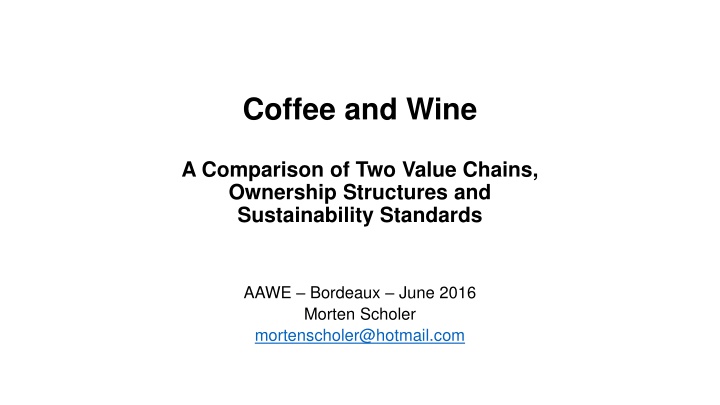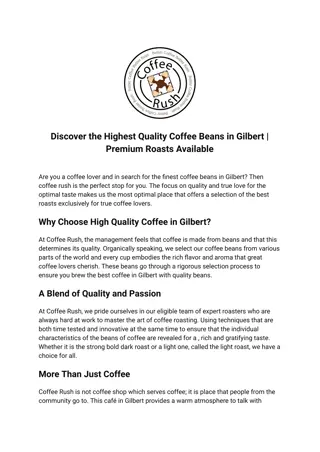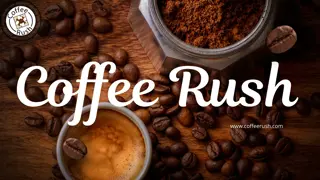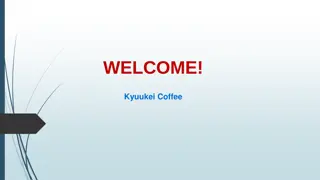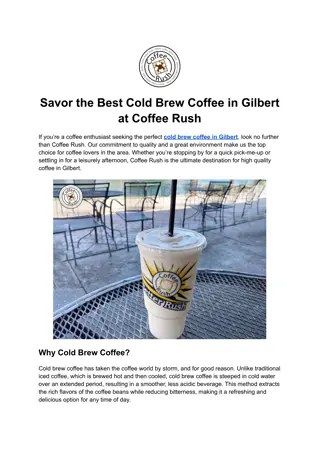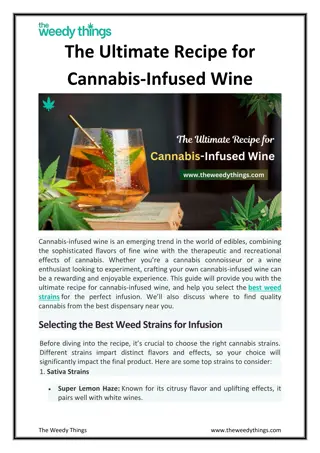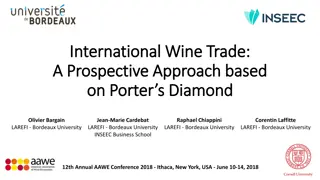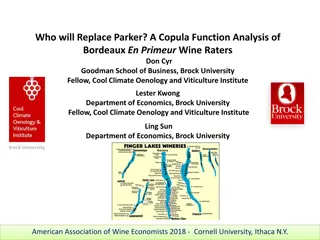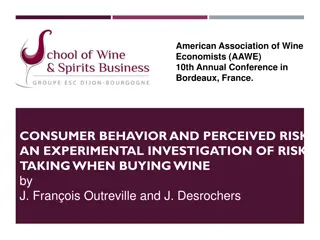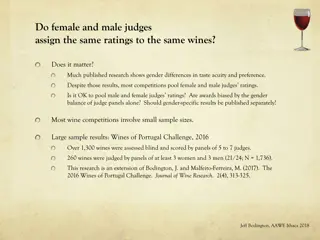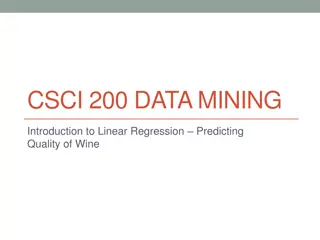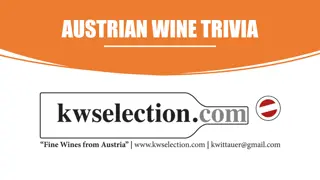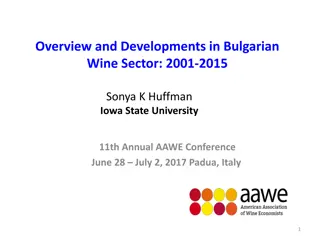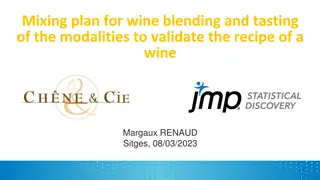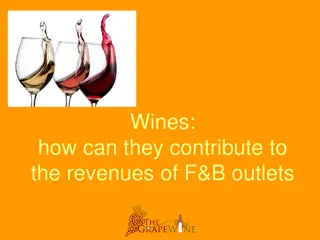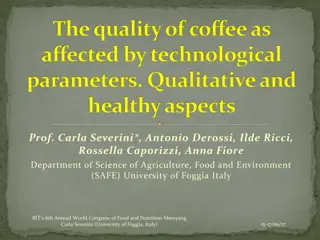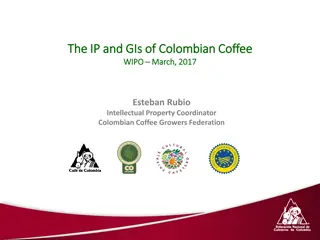A Comparative Analysis of Coffee and Wine Industries
Comparing the value chains, ownership structures, and sustainability standards of the coffee and wine industries. Explore the production processes, quality enhancement options, and key companies involved in these sectors. Gain insights into the similarities and differences between coffee and wine from cultivation to consumption.
Download Presentation

Please find below an Image/Link to download the presentation.
The content on the website is provided AS IS for your information and personal use only. It may not be sold, licensed, or shared on other websites without obtaining consent from the author.If you encounter any issues during the download, it is possible that the publisher has removed the file from their server.
You are allowed to download the files provided on this website for personal or commercial use, subject to the condition that they are used lawfully. All files are the property of their respective owners.
The content on the website is provided AS IS for your information and personal use only. It may not be sold, licensed, or shared on other websites without obtaining consent from the author.
E N D
Presentation Transcript
Coffee and Wine A Comparison of Two Value Chains, Ownership Structures and Sustainability Standards AAWE Bordeaux June 2016 Morten Scholer mortenscholer@hotmail.com
Coffee Flowering, cherries and green beans http://upload.wikimedia.org/wikipedia/commons/c/c7/Coffee_Flowers.JPG
Coffee Two species Arabica Robusta Ethiopia via Mocca, Arabia Lake Victoria Uganda, D.R.C. Origin 60 % 40% Share of World production Latin America, East Africa, South East Asia Vietnam + other S.E. Asia, Brazil, West/Central Africa Fine-flavoured aromatic (1.0 1.5%) Strong and harsher (filler) ( 2% ) Quality (Caffeine) ICE, New York LIFFE, London Exchange
Coffee and wine Two value chains Coffee Wine Field work Harvest In-land trading Primary processing (dry or wet) Milling Sorting Stuffing (bags or bulk) Sale from exporter . Border Shipping Storage In-land transportation Roasting Blending Packing Sale to professional or retail Grinding Brewing (professional or at home) Serving drinking Field work Harvest De-stemming, sorting, crunching Maceration Fermentation Storage (aging) Blending Bottling Sale from producer .. ... Border ... Shipping Storage In-land transportation Sale to professional or retail Serving drinking
Options for enhancement of quality Coffee (few) - Steam-cleaning (Robusta) - Aroma preservation (soluble/instant) - Dark roasting (a cover more than a genuine improvement) (many) Wine - Concentration (cryogenic/ice, evaporation, reverse osmosis, ) - Industrial yeasts huge choice with many functions - Chaptalization (adding sugar) - Acidification and de-acidification - Fining with additives - Cone-spinning in vacuum + high temp. (alcohol/aroma adjustment) - Oak-flavouring (using barrels, staves and chips)
Coffee and wine Large companies in the value chain Coffee Portion of World production (magnitudes) Investors JAB Holding (Benckiser, Reimann), Germany Wine J.M. Smucker, USA Gallo Winery USA 11% Neumann NKG Germany 10% ECOM (incl. Armajaro) 7% OLAM Singapore UK 7% EDF Man Volcafe 6% LouisDreyfus 4% Noble Hong Kong S pore 3% Sucafina 2% COEX Trading houses Constellation USA Switzerland The Wine Group USA UK Switzerland France CH NL Eight hold 50% Treasury Wine Group Australia Switzerland USA Penaflor (Trapiche) Argentina 13% Jacobs Douwe Egberts (Ex-SL/Kraft/Mondelez) NL 11% Nestl , incl. Nescaf and Nespresso Switzerland 5% Smucker s (Folgers, Milstone, ) USA 3% Elite-Strauss Israel USA 3% Tchibo 2% Starbucks USA 2% Lavazza 1.5% Keurig Green Mountain 1.5% Melitta 1.5% Segafredo-Zanetti 1.5% Aldi Germany 1.0% Kraft (Maxwell House, ) USA 1.0% UCC Japan Roasters / Brands Concha y Toro Chile Castel France Germany Eight hold 40% Accolade Australia Italy USA Germany Italy Pernod Richard France Bronco Wine USA Eight hold 10% 2% - Starbucks, USA Donkin Donuts, USA Outlets / Retail
Coffee Leading sustainability standards Standards with a main dimension Standards covering all dimensions Dimension - Organic Rainforest Alliance Environment UTZ Certified Amsterdam, Netherlands Utz Certified (Biodynamic, Shade-grown, Bird-friendly) ................ http://www.fairtrade.org.uk/images/homepage_new/images/logo.gif 4C ASSOCIATION - Fairtrade (FLO) 4C Social - Fair Trade USA ............. - Nespresso AAA - Starbucks C.A.F.E. Practice - Keurig Green Mountain s Responsible Sourcing Economic
Coffee and wine Four structural differences - Value chain (parties involved and physical transformations) Complex for coffee simpler for wine - Quality enhancement ( manipulation ) Only few options in coffee many in wine - Size of companies (relative size) Big in coffee (some have +10% of world trade) small in wine (all below 3%) - Sustainability standards Coffee is more complex than wine (coffee has worldwide standards, with more processes, locations and partners (sometimes illiterate))
